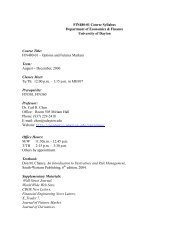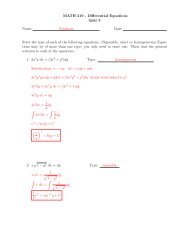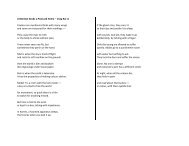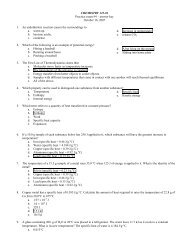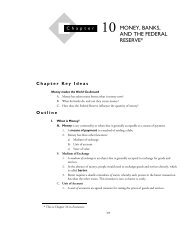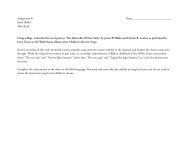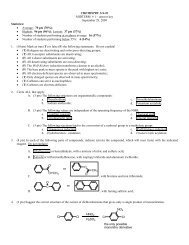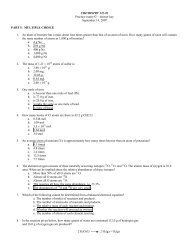Chapter 9 - University of Dayton Academic Webserver
Chapter 9 - University of Dayton Academic Webserver
Chapter 9 - University of Dayton Academic Webserver
Create successful ePaper yourself
Turn your PDF publications into a flip-book with our unique Google optimized e-Paper software.
300<br />
<strong>Chapter</strong> 9: Molecular Structures<br />
Larger alkanes will all follow the same pattern. Since they are saturated, all the carbon atoms have four<br />
bonds, and every one <strong>of</strong> them will have a tetrahedral shape and tetrahedral bond angles.<br />
40. (a) Write the Lewis structure. Use the VSEPR model to determine the electron-pair geometry <strong>of</strong> each <strong>of</strong> the<br />
atoms. Use Table 9.2 to determine the hybridization <strong>of</strong> the central atom using the electron-pair<br />
geometry. The bond angles are associated with the electron-pair geometry also, so use Figure 9.4.<br />
H<br />
H C<br />
H<br />
H<br />
C<br />
H<br />
H<br />
C C H<br />
C<br />
Look at the first two C atoms (the two farthest to the left): They are both <strong>of</strong> type AX 4E 0, so the<br />
electron-pair geometry is tetrahedral and these C atoms have sp 3 . hybridization. The sp 3 -hybridized C<br />
atoms have tetrahedral bond angles <strong>of</strong> approximately 109.5°.<br />
Look at the second two C atoms (the two farthest to the right): They are both <strong>of</strong> type AX 2E 0, so the<br />
electron-pair geometry is linear and these C atoms have sp hybridization. The sp-hybridized C atoms<br />
have linear bond angles <strong>of</strong> approximately 180°.<br />
(b) The shortest carbon-carbon bond is the triple bond. That can be confirmed by looking up the bond<br />
lengths in Table 8.1.<br />
(c) The strongest carbon-carbon bond is the triple bond. That can be confirmed by looking up the bond<br />
energies in Table 8.2.<br />
41. The first bond between two atoms must always be a σ bond. When more than one pair <strong>of</strong> electrons are<br />
shared between atoms, they are always part <strong>of</strong> π bonds. So the second bond in a double bond and the<br />
second and third bonds in a triple bond are always π bonds.<br />
(a)<br />
π<br />
H σ<br />
C σ N.<br />
(b) (c)<br />
H<br />
σ<br />
. .<br />
N<br />
π<br />
σ<br />
..<br />
N<br />
π<br />
σ<br />
H<br />
H<br />
σ<br />
..<br />
π<br />
H<br />
H<br />
H<br />
C<br />
N N N<br />
σ<br />
σ<br />
H<br />
.. π .<br />
42. The first bond between two atoms must always be a σ bond. When more than one pair <strong>of</strong> electrons are<br />
shared between atoms, they are always part <strong>of</strong> π bonds. So the second bond in a double bond and the<br />
second and third bonds in a triple bond are always π bonds.<br />
(a) (b) (c)<br />
π<br />
O<br />
σ<br />
C<br />
π<br />
σ<br />
S. . . ..<br />
.<br />
H<br />
σ . . σ<br />
N<br />
H<br />
σ<br />
..<br />
O.<br />
σ<br />
H<br />
H σ C<br />
σ<br />
H<br />
π<br />
σ<br />
C σ C<br />
σ σ<br />
H H<br />
π<br />
σ<br />
O<br />
C<br />
C<br />
H<br />
..<br />
..




